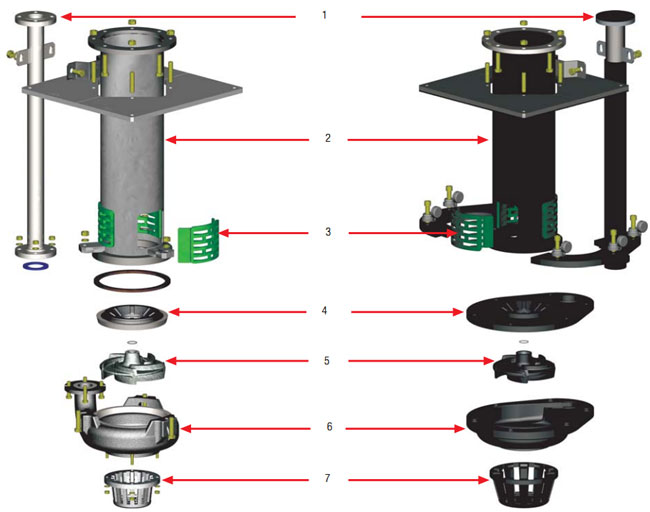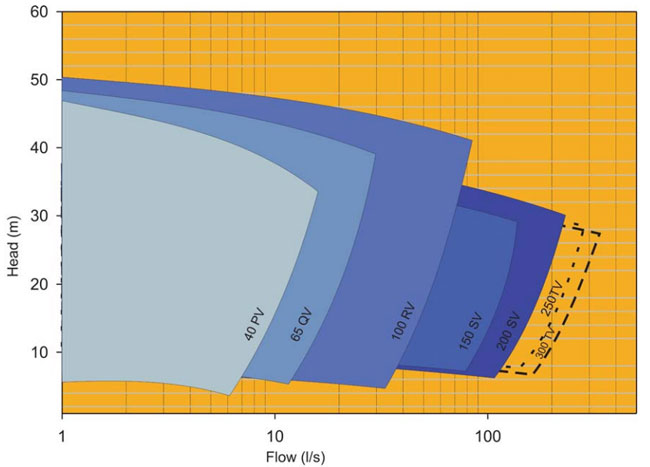SPR rubber Vertical Slurry Pump
Naipu SPR rubber Vertical Slurry Pumps are vertical, centrifugal slurry pumps submerged in sump to work.They are designed for delivering abrasive,large particle and high density slurries.These pumps have no need of any shaft seal and sealing water. They can also be operated normally for insufficient suction duties.Wet parts of type NP-SP pump are made of abrasion-resistant metal. All parts of type NP-SP(R) pump immersed in liquid are lined with rubber outer liner.They are suited to transport non-edge angle abrasive slurry.
Typical Applications---
Sump drainage washdown
Floor drainage
Mill sumps
Carbon transfer
Monitoring
Magnetite mixing
NP-SPR Construction Drawing

Main Part Number At The Drawing
|
1.Discharge Pipe
2.Column 3.Strainer 4.Back Liner |
5.Impeller
6.Pump Casing 7.Lower Pipe |
Materials of Construction
|
|
IMPELLERS |
CASING |
COLUMN |
DISCHARGE |
SEALS |
|
Standard |
High Chrome Alloy Rubber |
High Chrome Alloy Rubber |
Mild Steel |
Mild Steel |
Natural Rubber |
|
Options |
Butyl |
Neoprene |
Neoprene |
Neoprene |
Nordel |
Selection Chart

SP SUMP PUMP PERFORMANCE PARAMETERS
|
Type |
Allowable Mating Max. Power(Kw) |
Range Of Performance |
Impeller |
|||||
|
Capacity/Q |
Head/m |
Speed/rpm |
Max Efficiency/% |
No. of Vanes |
Impeller Diameter/mm |
|||
|
m³/hr |
L/S |
|||||||
|
40PV-NP-SP |
15 |
19.44-43.2 |
5.4-12 |
4.5-28.5 |
1000-2200 |
40 |
5 |
188 |
|
65QV-NP-SP |
30 |
23.4-111 |
6.5-30.8 |
5-29.5 |
700-1500 |
50 |
5 |
280 |
|
100RV-NP-SP |
75 |
54-289 |
15-80.3 |
5-35 |
500-1200 |
56 |
5 |
370 |
|
150SV-NP-SP |
110 |
108-479.16 |
30-133.1 |
8.5-40 |
500-1000 |
52 |
5 |
450 |
|
200SV-NP-SP |
110 |
189-891 |
152.5-247.5 |
6.5-37 |
400-850 |
64 |
5 |
520 |
|
250TV-NP-SP |
200 |
261-1089 |
72.5-302.5 |
7.5-33.5 |
400-750 |
60 |
5 |
575 |
|
300TV-NP-SP |
200 |
288-1267 |
80-352 |
6.5-33 |
350-700 |
50 |
5 |
610 |
Spr Rubber Vertical Slurry Pump,40Pv Rubber Slurry Pump,65Qv Rubber Vertial Pump,100Rv Rubber Slurry Pump
Shijiazhuang Naipu Pump Co., Ltd. , https://www.naipu-pump.com